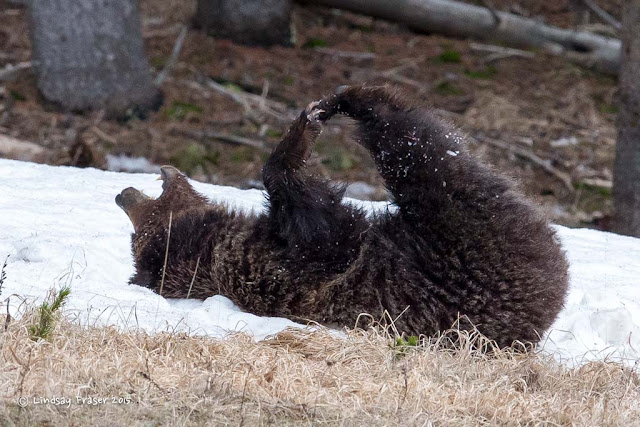You too can Photograph Wildlife
Why is shooting wildlife different to say landscape?
Because they move and there is often not much light as the best times to shoot are just after sunrise and just before sunset.When we came to Yellowstone for the first time we had no idea how to photograph wildlife. I was still photographing in P mode most of the time which works fine if there is plenty of light and your subject isn't moving. I would change to shutter priority to slow the water down for waterfalls and again to freeze anything taken out of a helicopter. I couldn't get enough light and I couldn't get a sharp picture. I tried shutter priority on animals but the pictures were just too dark. There are a number of ways to get a good photograph, you just need to find what works for you.
Setting up your camera
The following are Canon settings but I'm sure other brands have similar names. You might have to get your manual out!- Set your metering mode to "centre-weighted average metering" to help with lighting
- Set your AF mode to "Al Servo" which helps track moving subjects
- Select your drive mode: to "high speed continuous shooting", this will allow you to rattle off as many shots as your camera will allow. The 1DX takes 12 frames per second!
- Set your aperture setting. Start with f/4 or f/5.6 - if you want more of the background in focus, use a larger number (less light will come in as it's a smaller hole).
- Select single point AF (auto focus)
- Set your ISO. The more light there is, the lower the ISO is needed. The less light there is, you will need a higher ISO. Depending on the capabilities of your camera, your pictures may become grainy if you have the ISO too high. Depress your shutter button to look at your other settings. What is the shutter speed reading? Alter your ISO so that the shutter is reading around 1000/s. Remember as the day gets brighter or darker, alter your ISO
- If it is really dark, you may need to increase your exposure settings by 1/3 of a stop. This is a last resort as it will introduce noise into your picture. Try not to alter your exposure.
- Take a picture and check your histogram, does the graph have a nice curve to it? Look at your picture, how does it look?
- The most important thing is to use a tripod, especially with any lens over 200mm.
- The hardest thing to remember is to revisit your settings and change your ISO throughout the day. I still forget!
 |
| f/5 1/2500 ISO250 |
Calibrate your lenses
All lenses and camera bodies need to be calibrated to ensure maximum sharpness. We bought a 1.4x extender and I was never happy with the results. All the photographs looked out of focus which made it unusable. A professional photographer asked us if we had calibrated our lenses. Huh? how do you do that? We didn't even realise that this could be done. The product we use to calibrate our lenses is Lens Align & Focus Tune.We calibrated all our fixed lenses with and without the extender. Thankfully your camera knows what lenses you have attached to your camera and will automatically use the new settings. And now I use the extender!
 |
| f/6.3, 1/1250, ISO 2500 This was after 4pm, there was no sun and she was doing yoga! |



I was at the NW Overland Rally in eastern Washington state last weekend and went to some classes that motivated me to get a better camera. Needing enough light was clearly stressed, and I know to do that you need a good sized sensor (and for people subjects a good flash). And then your wonderful write-up about light appeared. It came at the perfect time! You guys are great!
ReplyDeleteThank you Fred. If I can inspire/help even one person, then I am happy!
Delete